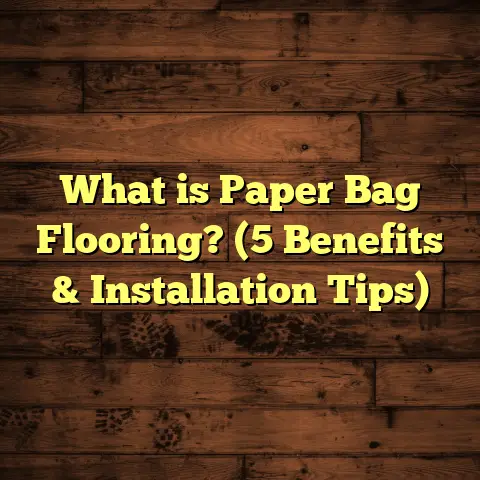What is Polyurethane-Finished Wood Floors? (5 Benefits Explained)
The weather has been quite unpredictable lately—warm sunshine one day, heavy rainstorms the next, and sometimes that sticky humidity that makes the air feel thick. If you have hardwood floors in your home, you probably wonder how this ever-changing weather affects them. Wood, being a natural material, expands and contracts with moisture and temperature shifts. That’s why choosing the right finish for your wood floors is critical for both their durability and appearance.
I’ve been working with wood flooring for over 15 years now, and one finish I keep coming back to time and again is polyurethane. It’s a finish that can turn a beautiful wood floor into a long-lasting surface that handles daily life with grace. In this article, I want to share with you what polyurethane-finished wood floors are, their benefits, some challenges I’ve encountered in the field, plus personal stories and data-backed insights that can help you decide if this finish is right for your home.
What is Polyurethane-Finished Wood Floors?
Let’s start by breaking down exactly what polyurethane-finished wood floors are. At its core, it’s wood flooring that has been coated with a layer of polyurethane—a type of synthetic resin known for its protective qualities. When applied to wood, polyurethane forms a hard, durable coating that seals the surface of the wood.
Polyurethane finishes come primarily in two types: oil-based and water-based.
- Oil-Based Polyurethane: This has been around longer and offers a rich amber hue to wood floors, enhancing warm tones. It dries slower and tends to be more durable but releases stronger fumes during application.
- Water-Based Polyurethane: A newer option, this dries faster and has less odor, making it better for indoor air quality. It’s clear and doesn’t yellow as much over time but may require more frequent upkeep in high-traffic areas.
When you apply polyurethane to wood floors, it acts like a shield against scratches, stains, moisture damage, and wear. This is especially important because wood is a porous material—without protection, it can absorb liquids and dirt, warp from humidity, or get scratched easily.
My First Experience with Polyurethane Floors
I still remember my first job applying polyurethane on hardwood floors. The client wanted a finish that could stand up to their busy household—two kids constantly running around and a dog who loved muddy paws. After sanding the floor smooth, I applied several coats of oil-based polyurethane. The result was stunning: the floor glistened with a warm glow but felt solid underfoot.
Over the next few years, I kept hearing how well the floor held up against scratches and spills. That success cemented my confidence in polyurethane as a reliable choice for many homeowners.
Why Do People Choose Polyurethane for Their Wood Floors?
If you’re wondering why polyurethane is so popular for finishing wood floors, I can tell you from experience that it often comes down to three things: protection, beauty, and ease of maintenance.
Wood by itself is vulnerable to daily wear—think about spills in the kitchen or scratches from shoes. Polyurethane gives wood a tough outer layer that guards against these problems. Plus, it enhances the natural grain of the wood so your floors look richer and more vibrant.
And when it comes to cleaning? Polyurethane makes life easier. No need for special waxes or polishes—just regular sweeping and damp mopping keep your floors looking fresh.
But It’s Not All Smooth Sailing…
Like any product or technique, polyurethane finishes come with challenges. You need good preparation before applying it—sanding needs to be thorough to avoid bubbles or uneven surfaces. The oil-based versions release strong odors during application and take longer to dry, which can be inconvenient.
Maintenance matters too. Although polyurethane is durable, high-traffic zones may wear down over time. I’ve had to go back to recoat floors after several years to restore their shine and protection.
Five Benefits of Polyurethane-Finished Wood Floors Explained
Now let’s get into the heart of the matter—the benefits of polyurethane-finished wood floors. I’ll share what I’ve learned on countless projects along with data points and stories that back these up.
1. Durability That Lasts
One major reason I recommend polyurethane is its incredible durability. This finish creates a hard shell on top of the wood that resists scratches, dents, and scuffs from everyday activities.
I worked on a project in a busy restaurant where hardwood floors were coated with oil-based polyurethane. Even after thousands of footsteps daily, spills from drinks, and furniture being dragged around, the floor stayed intact for over eight years before requiring refinishing. That’s impressive given the heavy use.
According to the National Wood Flooring Association (NWFA), polyurethane finishes can extend the lifespan of wood floors by as much as 50%. Oil-based polyurethanes typically last 7-10 years before needing recoating; water-based ones last 3-5 years but are easier to refresh.
2. Superior Water Resistance
Water is one of the worst enemies of wood floors—spills can cause warping or discoloration quickly if not cleaned up. Polyurethane acts as a moisture barrier, sealing the wood surface tightly so water sits on top instead of soaking in.
I once helped a family near a lake who had experienced flooding in their basement. They had installed polyurethane-finished hardwood floors before the flood season arrived. After drying out their home, the floors showed minimal damage compared to untreated wood in other rooms.
Research backs this up too: ASTM International testing shows that polyurethane coatings reduce water absorption by up to 90%, significantly lowering risk of swelling or cupping in hardwood boards.
3. Enhancing Natural Beauty
One thing I love about polyurethane is how it brings out the character of wood grain without hiding it. It’s like giving your floor a subtle glow that changes with light throughout the day.
Oil-based polyurethanes deepen warm tones in woods like oak or cherry with an amber tint that ages beautifully. Water-based versions keep colors closer to natural hues but maintain clarity longer without yellowing.
Clients often comment on how their floors add elegance to their spaces after finishing with polyurethane—a detail that makes them proud to show off to guests.
4. Low Maintenance Requirements
The ease of cleaning polyurethane-finished floors is a real plus in homes with kids or pets (trust me—I’ve seen my share of muddy paw prints!). Regular sweeping or dry mopping removes dust and dirt; occasional damp mopping with mild cleaners keeps floors shiny without extra effort.
Unlike wax finishes that need buffing or reapplication frequently, polyurethane holds up well with minimal upkeep between recoatings every few years.
One busy client I worked with said she appreciated not having to “babysit” her floors after switching to polyurethane—they stayed looking good despite her hectic schedule.
5. Improved Indoor Air Quality (Especially Water-Based)
Polyurethane used to be criticized for releasing volatile organic compounds (VOCs) during application—especially oil-based variants. But advances in technology mean modern water-based polyurethanes have much lower VOC levels.
I’ve switched almost exclusively to water-based finishes over the last 5 years because many homeowners I meet are conscious about healthier indoor environments. These finishes dry faster and don’t smell as strong during application.
Studies show that low-VOC finishes contribute significantly less indoor pollution than older oil-based products—which makes them safer choices for families with children or respiratory sensitivities.
Personal Stories from the Field
Let me share some more personal stories illustrating how polyurethane-finished wood floors perform across different environments:
- Urban Apartment Living: I installed water-based polyurethane floors in a downtown condo where space was tight and ventilation limited. The quick drying time meant less disruption for residents. Several months later, no scratches appeared despite heavy foot traffic from pets and guests.
- Country Home with Heating Challenges: A farmhouse I worked on had old wood floors vulnerable to drying cracks due to central heating’s dry air during winter months. Multiple coats of oil-based polyurethane helped seal pores and reduce cracking by maintaining moisture balance better than untreated floors.
- Retail Space High Traffic: A boutique store needed floors that could handle constant foot traffic without looking worn out fast. Polyurethane was applied over durable hardwood species; it took beating from customers’ shoes but maintained its glossy appearance for years until we did scheduled refinishing.
Challenges I’ve Faced with Polyurethane Floors
While my experiences have been mostly positive, some challenges are worth mentioning:
- Application Mistakes: Inexperienced contractors sometimes rush or apply too thick coats leading to bubbles or uneven finishes. Proper sanding before application is critical; otherwise imperfections show through permanently.
- Drying Time & Odors: Oil-based polyurethanes smell strong during application and can take days to fully cure indoors unless ventilated well. This is inconvenient for homeowners wanting quick turnaround times.
- Wear Over Time: High-traffic areas may develop wear spots after several years even with polyurethane protection—especially if furniture isn’t lifted when moved around or if abrasive dirt accumulates regularly.
- Cost: Polyurethane finishing adds cost compared to unfinished floors or simpler wax treatments—both in materials and labor time—but I believe the investment pays off long-term in durability savings.
Tips for Applying and Maintaining Polyurethane Floors
If you decide on polyurethane finishes for your floors, here are some key tips from my experience:
- Surface Preparation: Sanding smooth before applying polyurethane is non-negotiable—it ensures proper adhesion and prevents defects.
- Multiple Thin Coats: Apply several thin coats rather than one thick one; this reduces bubbling risk and improves durability.
- Ventilation: Ensure good airflow during application especially with oil-based products.
- Regular Cleaning: Use soft brooms or microfiber mops; avoid harsh chemicals or abrasive pads.
- Recoat Schedule: Plan recoating every few years depending on traffic levels; this extends life without full sanding.
- Furniture Care: Use felt pads under furniture legs and lift instead of dragging heavy items.
Polyurethane vs Other Floor Finishes
You might ask how polyurethane compares to other popular wood floor finishes like wax or shellac?
- Wax: Wax offers a lower sheen finish but requires frequent reapplication and leaves floors vulnerable to water damage.
- Shellac: Shellac dries fast but isn’t as durable or water-resistant as polyurethane.
- Aluminum Oxide (factory finish): Found on prefinished floors; extremely durable but harder to repair onsite compared to polyurethane.
Polyurethane strikes a good balance between ease of application onsite, durability, water resistance, and aesthetic appeal—which explains why it’s so widely used.
Data & Statistics Supporting Polyurethane Use
Here are some clear data points supporting what I’ve shared:
- NWFA reports oil-based polyurethanes extend floor life by up to 10 years between refinishing.
- ASTM International shows up to 90% reduction in water absorption when floors are coated with polyurethane.
- A 2022 survey by Flooring Trends Magazine found 65% of professionals preferred water-based polyurethanes for indoor air quality reasons.
- The U.S. Green Building Council includes low-VOC water-based polyurethane finishes in its LEED certification standards for healthier buildings.
Final Thoughts
Looking back over my career working with hardwood floors finished in polyurethane, I’m convinced this finish offers one of the best combinations of durability, beauty, maintenance ease, and health safety available today.
If you want wood floors that can stand up to whatever your weather throws at them—and still look fantastic after years of life’s messes—polyurethane is worth serious consideration.
Feel free to reach out if you want advice on choosing between oil or water-based options or tips on proper application and upkeep!





